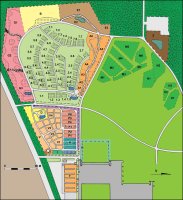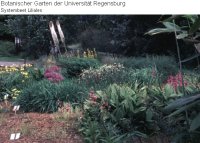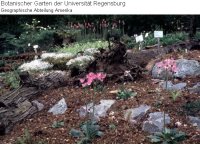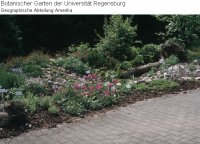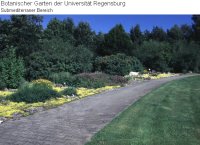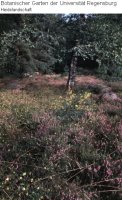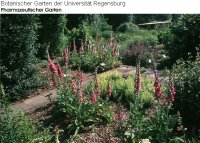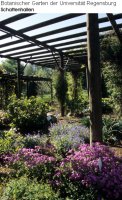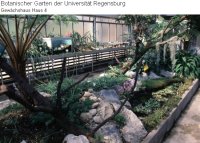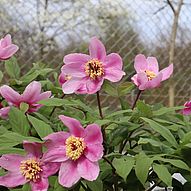
Overview
The Botanical Garden of the University of Regensburg has a comparatively short history in contrast with the two thousand year history of the city of Regensburg. The University of Regensburg was only built in the 1960’s and construction of the Botanical Garden began in 1977. There have been several attempts to found botanical collections in Regensburg in the past, but these projects never lasted for very long. Hopefully the current garden with its 4.5 hectares situated at the southern fringe of the city will be a permanent feature.
Systematic Section
The heart of the garden is the Systematic Section. It was designed to present the evolutionary relationships amongst the Angiosperms. The most primitive species are situated at the bottom of the slope. From there, symbolizing the evolutionary development, several system-arms ascend to finally merge at the top of the slope into the highest developed species of the plant kingdom.
The Systematic Section of the Regensburg Garden deviates from the usual sequence of beds of traditional Systematic Garden concepts, still found in older botanical gardens, creating a more interesting experience. The Regensburg Systematic Section integrates trees and shrubs belonging to the respective systematic groups, creating small scale structures with views and look-throughs. In some cases accessories indicate the habitat of the plants, for example boulders for Saxifrages and Crassulaceae. Aquatic plants have also been integrated into the Systematic Section by using smaller or larger water basins. In many cases the water basins have been lined with wooden sleepers to invite the visitor to sit down and linger. The different bodies of water offer a large diversity of aquatic habitats. Evidence for this is the 12 species of dragonfly found in the garden.
Geographic Section
The southern margin of the Systematic Section borders on the Geographic Section. Originally the Geographic Section contained only woody species that, during the warm geologic Tertiary Era, could be found in the species rich summer-green deciduous and mixed coniferous forests extending as far north as Spitsbergen. In the following Ice Ages many of these plants disappeared while others managed to survive to the present day in the warmer zones of their continents. Many plant species that originated only after the glacial periods, can now also be found in this section.
The area is almost 4000 sq m and contains about 800 plant species. From east to west it is divided into the continents of America, Asia and Europe, with large stone cubes sunk in the soil forming the borders between the continents. These areas are appealingly laid out, using English landscape gardening elements. A multitude of beautiful and rare plants make this part of the garden definitely well worth seeing.
Submediterranean Section
Ein Teil der westlichen Abgrenzung der systematischen Abteilung wird vom Submediterranen Bereich gebildet. Pflanzen aus einer bestimmten Höhenstufe südlich der Alpen sind in diesem Areal anzutreffen. Ist auch der hintere Geländeabschnitt jener Anlage nur in Form einer einfachen Gehölzpflanzung vorhanden, so vermag doch der Vordergrund durch eine großzügige Staudenpflanzung mit thermophilen Arten zu gefallen. Die Pflanzung zeigt sich im Juni/Juli in einem farbenprächtigen Zustand, wenn Felsennelke, Graslilie, Mauerpfeffer und diverse Klee-Arten zusammen mit einer ganzen Reihe anderer Pflanzen ihren Blütenhöhepunkt erreichen.
Systematic Section
Lining the western margin of the Systematic Section is the Sub-Mediterranean Section. Plants originating from a specific altitudinal belt south of the Alps can be found here. Though the area behind this section consists of a simple planting of woody species, the foreground consists of a generous planting of thermophilous perennials. The planting is most colourful in June and July when Petrorhagia, Anthericum, Wallpepper and several clover species together with many other species reach their height of flowering.
Oak-Birch Forest and Heathland
Northwards the back of the Sub-Mediterranean Section merges into an Oak-Birch Forest, which occurs naturally in Western and NorthWestern Europe on sandy, acid and nutrient poor soils. During the history of mankind large scale logging of this forest type, followed by live-stock grazing, lead to a different vegetation type, namely Heathland. The wide open spaces covered by heathland, next to the Oak-Birch Forest, demonstrates the large impact humans can have on nature. While the Atlantic Heath, with its wide expanses of scotch heather interspersed with glacial boulders, depicts the atmosphere of the Lüneburg Heath in Northern Germany, the appearance of the Broom Heath, found in Western Europe, is dominated by gorse and broom.
Integrated within the Heathland is a small inland dune, like they were formed after the retreat of the glaciers in largely vegetation-free areas.
Riparian Forest
The north side of the Systematic Section is bordered by a planting of Riparian Forest types. These vegetation types are characterised by frequent flooding or high ground water levels and are planted along an artificial brook. The most attractive view is offered by the Black Alder fen wood and Ash-Elm riparian forest in the upper course of the brook. In March and April the forest floor is covered with a carpet of flowers of snowflake, oxlip, wood anemone, marsh marigold, lesser celandine and wood garlic. In 2008 the lower course of the brook was planted with a specially laid out vegetation type within the Riparian Forest Formation Pre-Alpine Grey Willow Community. Here one can discover the very rare and endangered Bodensee Forget-Me-Not.
Central European Deciduous Forest, Coniferous Forest and Tundra
Outside the garden fence the Riparian Forest joins the Central European Deciduous Forest Zone, which shows how our vegetation would look without human intervention or special habitat factors such as high groundwater levels. The neighbouring Northern Coniferous Forest Zone represents the vegetation of the northern latitudes also known as Taiga. When travelling north in the Northern hemisphere, the Taiga-vegetation forest cover declines and is replaced by a treeless Dwarf Shrub Tundra characterised by shrubs and forbs. Our Tundra also includes a Tundra Moor which can be explored by walking on a boardwalk built over the Moor.
Vegetation does not only change along latitudinal gradients but also with altitude. The bordering Alpine Altitudinal Belts Section presents the various vegetation types above the deciduous forest belt.
Experimental and Propagation Area, School Garden
East of the Systematic Section the gentle slope continues downwards and passes into the lower part of the garden and a small greenhouse area.
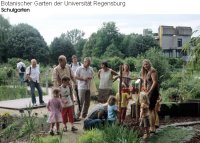 Almost half of the lower part of the garden is occupied by the Experimental and Propagation Area. In spring and summer the area appears with flowering perennials that are used for teaching and research and for the planting of the various thematic areas. The interspersed lawns function as exhibition area of the Bavarian Sorbus collection that is currently being build up.
Almost half of the lower part of the garden is occupied by the Experimental and Propagation Area. In spring and summer the area appears with flowering perennials that are used for teaching and research and for the planting of the various thematic areas. The interspersed lawns function as exhibition area of the Bavarian Sorbus collection that is currently being build up.
The south-western part of the lower garden is devoted to the School Garden, which includes two biotopes, a pond and a dry hill. In recent years, sections especially interesting for children were added such as a Path of Senses, Artificial Nesting Aids for Wild Bees, an Herbal Spiral and Sound Games. The experimental beds in the school garden were also considerably enlarged to give biology didactic students the possibility to gather experience about nature.
Endangered Plants of Bavaria, Biological Groups
Not far from here, on a former part of the Experimental and Propagation area, the section Endangered Plants of Bavaria was established in 2004. It was initiated by the Chair of Botany of the University of Regensburg whose research focuses on biodiversity, ecology and nature conservation. Here the botanical garden maintains an exhibition area for endangered plant species. Some of the rarest plant species of Germany like Parnassus Leaved Water Plantain (Caldesia parnassifolia) and Augsburg Field Fleawort (Tephroseris integrifolia ssp. vindelicorum) are being cultivated here.
Situated next to the Endangered Plants of Bavaria section is the section Biological Groups. In this area plants are grouped according to certain life forms and traits of plants related to flower anatomy, inflorescences, pollination and others. This gives the Botany students the opportunity to deepen their theoretical knowledge using live plants.
Pharmaceutical Garden
Like many other botanical gardens, the Regensburg Garden also has a Pharmaceutical Garden. This section situated in the north-western corner of the lower garden is terraced. The lowermost terrace features poisonous plants, while the higher terraces have plants grouped according to secondary compounds such as alkaloids, saponines and glycosides.
Greenhouses
The Greenhouse Area open to the public covers about 450 sq m and is divided into four houses. Mainly ferns, bromeliads and orchids are cultivated in House 1, whereas in House 2 insectivorous plants and useful plants originating from the temperate regions of the world can be found. House 3 harbours tropical rainforest plants including a variety of tropical plants of economic importance. Cacti and other succulents are housed at the back of House 4 while the front contains Mediterranean plant species and insectivores from the cooler regions of the earth.


